Abstract
This paper proposes a geometrically intuitive error modeling method for planar parallel mechanisms (PPMs) based on conformal geometric algebra (CGA). First, the end point of each limb is determined through rotational transformations in geometric algebra. Using this point as the center, the kinematic geometry body (KGB) of each limb is constructed. The end-effector position of the parallel mechanism is then obtained via intersection operations in CGA, while its orientation is derived by constructing the motion plane from the end points. Finally, the error model of the parallel mechanism is established through differential operations. To validate the proposed method, a kinematic calibration simulation was performed using a 3-RPR planar parallel mechanism as an example. The simulation results demonstrate a significant reduction in both position and orientation errors after calibration, indicating a substantial improvement in accuracy and verifying the correctness of the approach.
1. Introduction
Parallel manipulators (PMs) are widely used in various fields because of their strong bearing capacity, high stiffness, and excellent dynamic performance []. Among them, 3-DOF planar parallel mechanisms (PPMs) are widely used in high-precision positioning and precise operation fields. Considering symmetry, planar parallel mechanisms can be classified into 10 types [], as shown in Figure 1, with single and double arrows representing revolute and prismatic joints, respectively. The underlined parts represent the driving joints. During the production process, deviations in manufacturing and assembly can arise, which may compromise the operational precision of PMs. The literature indicates that geometric inaccuracies are among the most significant contributors to these errors [,,]. Consequently, enhancing the accuracy of PMs continues to be a vital focus of research. Although methods like improving machining tolerances can aid in achieving higher precision, kinematic calibration has proven to be a more cost-efficient and practical approach for enhancing the positioning accuracy of such systems.

Figure 1.
The basic 3-DOF PPMs with identical legs.
Error modeling is the first step of kinematic calibration. Its principal aim is to formulate a mathematical framework that correlates joint displacement errors with the spatial pose of the end-effector []. Although error modeling methods for serial manipulators are now well-established, corresponding methodologies for PMs remain underdeveloped and necessitate considerable advancement in multiple areas. Attaining high-precision calibration performance requires the construction of an error model that ensures completeness, continuity, and independence among parameters, as these properties are fundamental to obtaining accurate and trustworthy calibration results.
Many methods for error modeling have been proposed. Early studies predominantly relied on the Denavit–Hartenberg (D-H) convention [] to formulate error models for PMs. As an illustration, Wang and Masory [] utilized this methodology to establish an error model for a Stewart platform. Comparable D-H-based techniques have also been developed for PMs with reduced mobility. A significant drawback of the standard D-H method, however, is its breakdown in cases where two adjacent joint axes are collinear. This limitation has prompted the creation of multiple revised D-H conventions [,]. Nevertheless, despite such adaptations, the fundamental D-H parameters and their subsequent modifications continue to be constrained by inherent mathematical deficiencies and singularity problems. Therefore, these approaches remain inadequate for establishing a consistent mathematical structure required for holistic error modeling.
Another classic method is to apply the inverse kinematics or closed-form formulations, primarily due to the significant complexity inherent in forward kinematic computations [,]. However, error models developed via inverse kinematic solutions often depend on idealized structural assumptions, which may result in the omission of certain potential error sources. For instance, He et al. [] conducted a calibration study on a 2UPR-RPU PM using a differential inverse kinematics approach. Despite its utility, this method still fails to incorporate a complete set of error terms.
Two other established methodologies in this domain are the Product of Exponentials (POE) approach and screw theory. Initially introduced by Park and Okamura [] for calibrating PMs, the POE method was later refined through the Local POE formulation by Chen et al. [,], which bears structural similarities to Denavit–Hartenberg parameter-based techniques. The POE method has been applied and improved by many scholars [,,]. However, there is a problem with the POE method: the error term sometimes lacks clear physical meaning. Screw theory offers another rigorous framework for error modeling in PMs [,,]. For instance, Liu et al. [] developed a systematic strategy for geometric error modeling in limited-DOF PMs, clearly separating joint motion inaccuracies from geometric deviations. Although screw-based methods allow unified error representation, their reliance on instantaneous kinematics often complicates position-level analysis. Sun et al. [] addressed this by integrating finite and instantaneous screw theory to support intuitive error propagation and identification across both serial and parallel architectures. Alternative strategies, including the multi-loop circuit incremental method [] and unit dual quaternions [], have also contributed to the development of error models for such systems.
Conformal geometric algebra (CGA) belongs to 5-dimensional geometric algebras [,]. Within the framework of CGA, geometric entities such as points, lines, planes, and spheres can be represented with convenience. By leveraging the operations defined in CGA, rigid body transformations and geometric intersection operations can be effectively carried out. The application scope of CGA is remarkably extensive, spanning multiple disciplines including physics, computer science, and robotics [,]. CGA serves as a highly potent computational framework. In the domain of robotics, it is capable of addressing numerous crucial problems. These include the mobility analysis [], the direct and inverse kinematics [,,], the singularity analysis [,], and the configuration synthesis of PMs []. Specifically, Lian [] employed CGA to perform error modeling for PMs. In this method, the finite motion of an open-loop chain is firstly formulated. Through linearization of the finite motion, error propagation of the open-loop chain is analyzed. Then, motions and constraints of PMs are analyzed and geometric error model of PMs are formulated considering the actuations and constraints.
This work proposes a new method for error modeling of PPMs based on CGA. The advantage of this method is that it has geometric intuitiveness. Moreover, it is also universal. For different structures of PPM, there is no need to rederive the modeling process. All that is required is to replace some structural parameters. Section 2 offers a brief introduction on CGA and outlines the theoretical foundations employed. A generalized error model for PPMs is introduced in Section 3. Validation of the proposed framework is conducted in Section 4 via a case study on a 3-RPR parallel manipulator. Finally, some conclusions are presented in the Section 5.
2. Conformal Geometric Algebra
This section introduces fundamental theory of CGA used in this paper briefly. For details about CGA, please refer to the relevant reference books [,].
2.1. Fundamental Theory of CGA
CGA contains the three Euclidean basis vectors , , and two additional basis vectors , with positive and negative signatures, respectively. The two additional basis vectors satisfy the following equations.
3D origin and infinity can be defined by
and are all null vectors with the following properties:
where E is a unit pseudoscalar in CGA, and E2 = −1.
The main operations in CGA include geometric product “juxtaposition of two vectors”, inner product “” and outer product “”. The outer product can be used to solve the intersection of geometry.
2.2. Conformal Geometric Entities
Table 1 lists basic geometric entities, such as points, spheres, planes, circles, lines, and point pairs. These entities have two algebraic representations: the inner product null space (IPNS) and the outer product null space (OPNS). They are dual to each other.

Table 1.
Basic geometric entities in CGA.
From Table 1 we can see that a sphere can be constructed with a CGA point P and radius r. A 3D point can be represented in CGA form in the inner product null space. In the outer product null space, the intersection of four spheres gives us an intersection. They have the following relationship:
where is the inverse of E, .
The point can be obtained by the point-pair decomposition
where , , , .
In fact, three spheres and a plane can also intersect at one point. Figure 2 shows some possible cases of intersection.
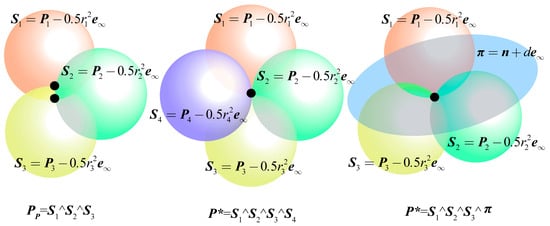
Figure 2.
Intersection point of spheres or spheres and plane.
2.3. Conformal Transformations
Transformations can easily be described in CGA. For example, the rotation of a rigid body can be written as follows:
where and are defined by Equation (9)
and n is the rotation axis, represented by a normalized bivector.
The translation of a rigid body can be described as
where and are defined by Equation (11)
A rigid motion containing rotation and translation can be described by the following geometric product:
where and are the original and transformed object, respectively. is a versor and is its reverse.
3. Error Modeling of PPMs Using CGA
The main idea of the method in this paper is to use the meet operation in CGA to deal with the error modeling of PPMs. By means of rotation transformation, the position of the last joint of the limb can be obtained. With this point as the center, a sphere can be constructed. This process is called constructing a limb kinematic geometric body. Similar operations can be performed on other limbs. In this way, we can construct three spheres and intersect them to get the center point of the moving platform. The orientation of the moving platform can also be derived using the endpoints of limbs. By using differential operations, the error model of PPMs can be derived. The error modeling process is shown in Figure 3. The detailed content will be introduced in Section 3.1, Section 3.2 and Section 3.3.
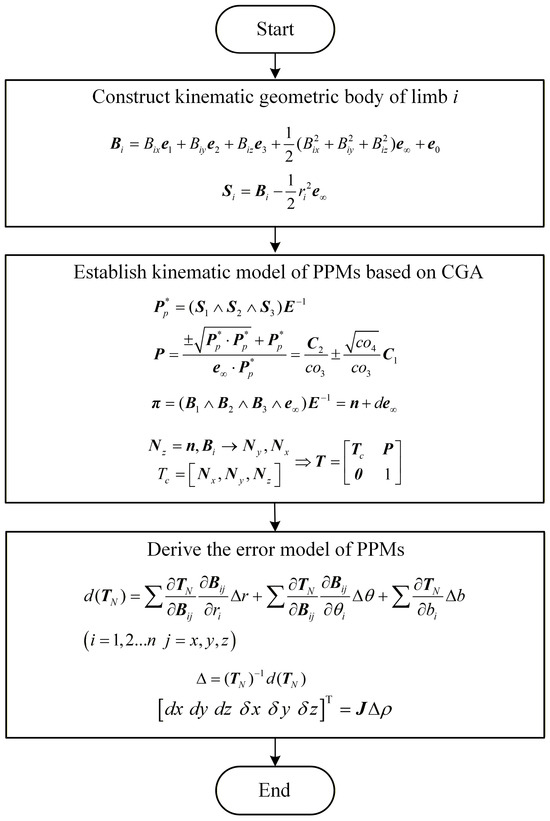
Figure 3.
Error modeling process based on CGA.
3.1. Construction of Limb KGB
Figure 4a shows 3-DOF PPMs, and each limb has n (n = 3) joints. For modeling purpose, reference frames are set on the base, moving platform, and joints. The first reference frame of limb i is located at O, and the last reference frame is located at O′. Frames associated with jth (j = 1, 2, …, n) joint are located at the center of each joint, and axis is set along the axis of the joint.

Figure 4.
Schematic diagram of a 3-DOF PPM. (a) Establishment of the coordinate system from the x-y perspective. (b) A KGB for limb i with a radius of r viewed from a three-dimensional perspective.
For limb i, the joint reference frame is transformed to the frame by the following transformation:
where
xj, yj, zj (, , ) (j = 1, 2, 3) are the geometric error components of Rj relative to Rj−1 along (about) three orthogonal axes of Rj−1.
Equation (14) encompasses both translational motion and rotational motion.
where , .(j = 1, 2, 3)
The pose of point Bi (i = 1, 2, 3) is
where is the coordinates of Bi.
The modeling process shown in Figure 2 is applicable to all planar parallel mechanisms. The only difference is that due to the variations in the limb structures, the transformations included when calculating point B are different.
The KGB of limb i can be constructed as
which is a sphere with its origin at point . The radius is defined by the distance bi from to the center of the moving platform P. Figure 4b shows the KGB of limb i. KGB is the accumulation of movements. The motion space of the moving platform is the intersection of all the KGBs on the limbs of the PPM.
3.2. Kinematics Analysis of PPMs Using CGA
The intersection of three KGB spheres gives a point pair
where
Note that, ideally, the center point of the moving platform can take a point in a point pair or the midpoint of a point pair; however, the center point of the moving platform can take the midpoint of a point pair if errors are considered.
According to Equation (18), the three-dimensional coordinate of the moving platform center is
where , , , , , , and A are shown in Appendix A. For planar parallel mechanisms, zo = 0.
The plane composed by Bi (i = 1, 2, 3), namely the moving platform is
where is the normal vector of , , , and d is the distance from the plane to the origin.
The components of the normal line of the plane in each direction are
The normalized vector is
where
The x axis of the moving platform constructed from Bi (i = 1, 2, 3) is
The normalized x vector is
where
The y axis of the moving platform constructed from Bi (i = 1, 2, 3) is
The normalized y vector is
where
According to the above deduction, the orientation matrix of the moving platform is
Then, the pose matrix of the moving platform is
where .
3.3. Error Modeling of PPMs
Equation (28) is a function of Bi (i = 1, 2, 3) and the moving platform radius bi, taking the derivative of Equation (28) with respect to parameters Bi and bi.
where is the difference between the actual and the ideal radius of the moving platform, and ΔBix, ΔBiy, ΔBiz are the differences between the actual and desired coordinates at point Bi (i = 1, 2, 3).
where , . (j = 1, 2, 3, j = 1, 2, 3)
The difference between the actual and ideal pose of the mechanism is
where
According to Equations (29) and (30),
where , , (i or j = 1, 2, 3).
can be obtained as
Based on the above deduction, the error vector can be obtained as
where J is the error matrix of the PM
4. Case Study
This section takes the 3-DOF planar 3-RPR PM as an example, and verifies the validity of the proposed error model through calibration simulation.
4.1. Architecture of the 3-RPR PPM
As shown in Figure 5, it is the 3-RPR PPM. The moving platform is an equilateral triangle, and it is connected to the fixed platform through three rotational joints. The three limbs are symmetrically distributed, and each limb contains two rotational joints R and one prismatic joint P, with the prismatic joint P being the driving joint. The axis of the rotational joint is perpendicular to the fixed platform and the prismatic joint P. The distances from the center point of the moving platform to B1, B2, and B3 are b1, b2, and b3 respectively. Ideally, b1 = b2 = b3. The moving distances of the three driving joints are q1, q2, and q3. A fixed reference coordinate system O-xy is established at point A1 on the fixed platform. Point O is located at A1, and the x-axis is along the direction of A1A2, and the y-axis is determined by the right-hand rule. A moving coordinate system O’-uv is established at the center point of the moving platform. The u-axis is along the direction of B1B2, and the v-axis is determined by the right-hand rule.
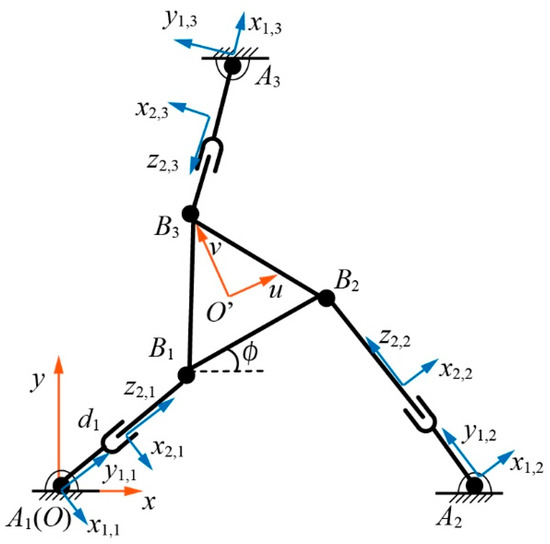
Figure 5.
Structural diagram of 3-RPR parallel mechanism.
The position and orientation of the moving platform are determined by the position of the center point O′(x, y) of the moving platform and the angle between the x-axis and B1B2. The coordinates of point Ai (i = 1, 2, 3) are A1 = (c1, d1, 0), A2 = (c2, d2, 0), A3 = (c3, d3, 0). The coordinates of point Bi (i = 1, 2, 3) in the moving coordinate system are = (−b1 cos, −b1 sin), = (b2 cos, −b2 sin), = (0, b3). Ideally, c1 = d1 = d2 = 0.
4.2. 3-RPR Planar PM Limb KGB Construction
In Figure 5, the coordinate systems of each joint are established []. The limb coordinate systems (i = 1~3) are established at point A1, and coincide with O-xy. The joint coordinate systems (j = 1~3) are established at joint j, with the axes along the joint axis direction and perpendicular to and .
(j = 1~3, i = 1~3) represents the homogeneous rotation transformation of joint j-1 relative to joint j on limb i. The three limbs of the 3-RPR mechanism are symmetrically distributed, and the transformation between each joint is as follows.
Move the coordinate system {O} along its x-axis by a distance of ci, along its y-axis by a distance of di, and then rotate it around the z-axis to transform it into the system {R0,i}, that is
where
{R0,i} moves a distance of qi along its y-axis, and then rotates around the x-axis by an angle of to transform into {R1,i}. The transformation is as follows:
where
{R1,i} rotates around its x-axis by an angle and is transformed into the coordinate system {R2,i}
where
The transformation of the entire limb is
From Equation (39), the conformal geometric expression form of Bi (i = 1, 2, 3) can be obtained. The Cartesian coordinates extracted from it are
The limb kinematic geometric bodies Si (i = 1, 2, 3) can be constructed as
4.3. Kinematics Analysis of 3-RPR Planar PM Using CGA
Three limb kinematic geometric bodies intersect to form a point pair, and the center point O’ of the moving platform is the midpoint of this point pair.
where
From Equation (44), the ideal position of the moving platform center point of the 3-RPR parallel mechanism is
where
The components of the planar normal vector composed of Bi (i = 1, 2, 3) in each direction are
The unitized normal vector is
where .
The x-axis of the mechanism is constructed along the B1B2 direction.
Normalize the x-axis vector as
where
The y-axis of the mechanism constructed from the midpoint of B2B1 to the B3 direction is
Normalize the y-axis vector as
where
From the derivations in Equations (47), (49) and (51), the orientation matrix of the moving platform is
The pose matrix of the moving platform is
where , 0 is a 0 vector of .
4.4. Error Modeling of 3-RPR Planar PM
The orientation matrix T is a function of the coordinates Bi (i = 1, 2, 3) and the length of the moving platform centerline bi. Differentiate with respect to the coordinates Bi and bi.
where represents the difference between the actual length and the ideal length of the centerline of the moving platform. ΔBix, ΔBiy, and ΔBiz are the differences between the actual and ideal values of the coordinates of Bi (i = 1, 2, 3).
Take the derivative with respect to Bi (i = 1, 2, 3)
where , (i or j = 1, 2, 3).
The difference between the actual pose matrix and the ideal pose matrix is
where
From Equations (54) and (56), we can obtain
where , , (i or j = 1, 2, 3).
can be solved as
The error model can be obtained as
where J represents the error matrix of the 3-RPR parallel mechanism. , , there are a total of 15 errors, they are , , , , , , , , , , , , , , and , respectively.
The redundant error parameters were analyzed using QR decomposition. It was found that the redundant error parameters were , , and . To avoid the influence of the redundant error parameters on the parameter identification results, these redundant error parameters were removed.
4.5. Simulation Verification of Error Model
The structural parameters of the 3-RPR parallel mechanism are set as c2 = 1 m, c3 = 0.5 m, d3 = m, b1 = b2 = b3 = m, and . Considering that the singular configuration has an impact on the stability of parameter identification, experimental points are selected within the non-singular workspace. In this paper, 30 points on a circular trajectory within the workspace are selected as experimental points. The circular trajectory simultaneously encompasses the movements in both the x and y directions, as well as the continuous changes in the end position, which can effectively trigger most or even all of the geometric errors. Each calibration point can provide two valid position equations, and there will be a total of 60 equations. These 60 equations are used to solve 15 error parameters. In terms of quantity, this is sufficient and provides good redundancy. The motion trajectory is shown in Figure 6.
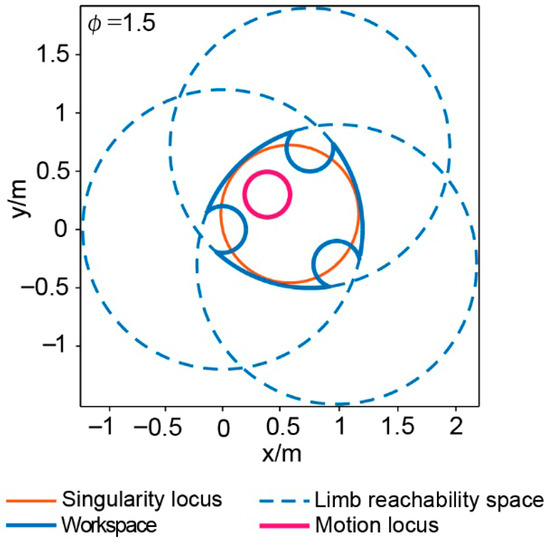
Figure 6.
Selection of reference points in the non-singular workspace of 3-RPR planar PM.
After selecting the simulation calibration points, the simulation identification is carried out through the error matrix. The identification process is shown in Figure 7. The error set value and the identified value are as shown in Table 2.
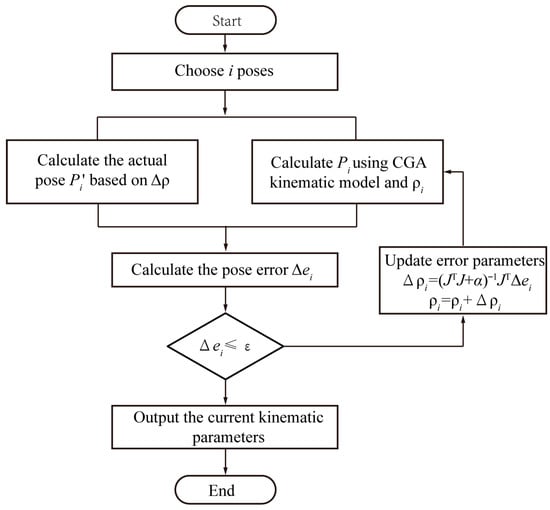
Figure 7.
Parameter identification flowchart.

Table 2.
The set values for parameter identification and the identified value.
- (1)
- Select the simulation calibration points, and the number of reference points should be greater than the number of error equations.
- (2)
- Set the initial kinematic error parameters and calculate the actual pose .
- (3)
- Based on the current kinematic parameters , the 3-RPR PM’s pose Pi is calculated using the CGA kinematic model.
- (4)
- Calculate the pose error and determine whether is less than the set value .
- (5)
- If the conditions are not met, then the regularization parameter identification algorithm is used to identify the error parameters, and then return to the third step to update the identified error parameters. The regularization parameter is set to 0.9.
- (6)
- When < , output the identified error parameters.
The parameter errors have been identified by five times iteration calculation and the pose errors are less than 10−5, which indicates that the error matrix can effectively identify the error parameters of the mechanism. The identified error parameter values in this table are then used to calculate the driving values, and the compensation and calibration simulation for the 3RPR PM is carried out.
The results before and after position error calibration are shown in Figure 8a, with the maximum value decreasing from 0.18 10−2 m to 0.25 10−3 m, and the average value decreasing from 1.6 10−3 m to 0.24 10−3 m. The results of the orientation error calibration are shown in Figure 8b, with the maximum value decreasing from 0.45 10−2 m to 0.33 10−3 m, and the average value decreasing from 0.4 10−2 m to 0.28 10−3 m. The experimental results indicate that after calibration, the position error and orientation error of the mechanism have been significantly reduced, proving the effectiveness of the error model.
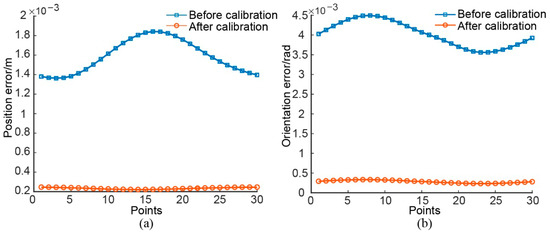
Figure 8.
(a) The position errors before and after calibration (b) The orientation errors before and after calibration.
In the simulation, to focus on the geometric error identification and eliminate the influence of dynamic effects, we adopted a quasi-static approach. The motion speed for both the identification path and the validation path was set to a constant low value of 0.05 m/s in terms of the end-effector’s linear velocity. This speed was selected based on the physical scale of the 3-RPR PPM to ensure that the entire calibration process operates in a quasi-static condition, where the positioning accuracy is dominated by geometric errors rather than dynamic forces. Thereby isolating and verifying the contribution of this work.
5. Conclusions
This paper proposes a novel error modeling method for planar parallel mechanisms based on conformal geometric algebra. The 3-RPR planar parallel mechanism is analyzed as an example. The kinematic geometry body of each limb of the 3-RPR mechanism is derived, and the kinematic model is obtained through intersection operations in CGA. By taking the total differential of the kinematic model, an error model is established. To validate the effectiveness of the CGA-based error modeling approach, a calibration simulation was conducted on the 3-RPR parallel mechanism. The simulation results show that the maximum position error was reduced from 0.18 10−2 m to 0.25 10−3 m after calibration, while the average position error decreased from 1.6 10−3 m to 0.24 10−3 m. Similarly, the maximum orientation error was reduced from 0.45 10−2 m to 0.33 10−3 m, and the average orientation error decreased from 0.4 10−2 m to 0.28 10−3 m. These results verify the effectiveness of the proposed error modeling method. Future work will be focused on the experimental validation of proposed error modeling method and its application to the error modeling and calibration of spatial parallel mechanisms.
Author Contributions
Conceptualization, H.Y. and X.C.; methodology, X.C.; software, C.T.; validation, C.T.; formal analysis, H.Y.; investigation, H.Y.; resources, X.C.; data curation, H.Y.; writing—original draft preparation, H.Y.; writing—review and editing, H.Y.; visualization, C.T.; supervision, X.C.; project administration, X.C.; funding acquisition, X.C. All authors have read and agreed to the published version of the manuscript.
Funding
This research was funded by the Research Start-up Fund for Introduced Talents, Anhui Polytechnic University under grant number 2021YQQ025, the Enterprise-Commissioned Project under grant number HX202312011, the Natural Science Foundation of Zhejiang Province under Grant LMS25E050107, and the National Natural Science Foundation of China (NSFC) under Grant 52205023 and 52275036.
Data Availability Statement
Data are contained within the article.
Conflicts of Interest
The authors declare no conflicts of interest.
Abbreviations
The following abbreviations are used in this manuscript:
| PM | Parallel mechanism |
| PPM | Planar parallel mechanism |
| CGA | Conformal geometric algebra |
| KGB | Kinematic geometric body |
| IPNS | Inner product null space |
| OPNS | Outer product null space |
Appendix A
References
- Merlet, J.P. Parallel Robots; Springer Science & Business Media: Berlin/Heidelberg, Germany, 2006; Volume 128. [Google Scholar]
- Bonev, I.A.; Zlatanov, D.; Gosselin, C.M. Singularity Analysis of 3-DOF Planar Parallel Mechanisms via Screw Theory. J. Mech. Des. 2003, 125, 573. [Google Scholar] [CrossRef]
- Roth, Z.; Mooring, B.; Ravani, B. An overview of robot calibration. IEEE J. Robot. Autom. 1987, 3, 377–385. [Google Scholar] [CrossRef]
- Mooring, B.W.; Roth, Z.S.; Driels, M.R. Fundamentals of Manipulator Calibration; Wiley: Brooklyn, NY, USA, 1991. [Google Scholar]
- Li, J.; Xie, F.G.; Liu, X.J. Geometric error modeling and sensitivity analysis of a five-axis machine tool. Int. J. Adv. Manuf. Technol. 2016, 82, 2037–2051. [Google Scholar] [CrossRef]
- Schröer, K.; Albright, S.L.; Grethlein, M. Complete, minimal and model-continuous kinematic models for robot calibration. Robot. Comput.-Integr. Manuf. 1997, 13, 73–85. [Google Scholar] [CrossRef]
- Wang, J.; Masory, O. On the accuracy of a stewart platform—Part I: The effect of manufacturing tolerances. In Proceedings of the IEEE International Conference on Robotics and Automation Los Alamitos, Atlanta, GA, USA, 2–6 May 1993; pp. 114–120. [Google Scholar]
- Hayati, S.A. Robot arm geometric link parameter estimation. In Proceedings of the 22nd IEEE Conference on Decision and Control, San Antonio, TX, USA, 14–16 December 1983; pp. 1477–1483. [Google Scholar]
- Stone, H.W. Kinematic Modeling, Identification, and Control of Robotic Manipulators; Kluwer Academic Publishers: Alphen aan den Rijn, The Netherlands, 1987. [Google Scholar]
- Masory, O.; Wang, J.; Zhuang, H. On the accuracy of a Stewart Platform—Part II kinematic compensation and calibration. In Proceedings of the 1993 International Conference on Robotics and Automation, Atlanta, GA, USA, 2–6 May 1993; pp. 725–731. [Google Scholar]
- Jiang, Y.; Li, T.M.; Wang, L.P. Chen Feifan. Kinematic error modeling and identification of the over-constrained parallel kinematic machine. Robot. Comput.-Integr. Manuf. 2018, 49, 105–119. [Google Scholar] [CrossRef]
- He, L.Y.; Li, Q.C.; Zhu, X.B.; Wu, C.Y. Kinematic Calibration of a 3-DOF Parallel Manipulator with a Laser Tracker. J. Dyn. Syst. Meas. Control. 2018, 141. [Google Scholar] [CrossRef]
- Park, F.C.; Okamura, K. Kinematic Calibration and the Product of Exponentials Formula. In Advances in Robot Kinematics and Computational Geometry; Lenarčič, J., Ravani, B., Eds.; Springer: Dordrecht, The Netherlands, 1994; pp. 119–128. [Google Scholar]
- Chen, I.M.; Yang, G.L.; Tan, C.T.; Song, H.Y. Local POE model for robot kinematic calibration. Mech. Mach. Theory 2001, 36, 1215–1239. [Google Scholar] [CrossRef]
- Chen, G.L.; Kong, L.Y.; Li, Q.C.; Wang, H.; Lin, Z.Q. Complete, minimal and continuous error models for the kinematic calibration of parallel manipulators based on POE formula. Mech. Mach. Theory 2018, 121, 844–856. [Google Scholar] [CrossRef]
- Kong, L.Y.; Chen, G.L.; Zhang, Z.; Wang, H. Kinematic calibration and investigation of the influence of universal joint errors on accuracy improvement for a 3-DOF parallel manipulator. Robot. Comput.-Integr. Manuf. 2018, 49, 388–397. [Google Scholar] [CrossRef]
- Wu, H.Y.; Kong, L.Y.; Li, Q.C.; Wang, H.; Chen, G.L. A Comparative Study on Kinematic Calibration for a 3-DOF Parallel Manipulator Using the Complete-Minimal, Inverse-Kinematic and Geometric-Constraint Error Models. Chin. J. Mech. Eng. 2023, 36, 121. [Google Scholar] [CrossRef]
- Kong, L.Y.; Xu, X.J. Calibration of a Polarimetric MIMO Array with Horn Elements for Near-Field Measurement. IEEE Trans. Antennas Propag. 2020, 68, 4489–4501. [Google Scholar] [CrossRef]
- Sun, T.; Lian, B.B.; Yang, S.F.; Song, Y.M. Kinematic Calibration of Serial and Parallel Robots Based on Finite and Instantaneous Screw Theory. IEEE Trans. Robot. 2020, 36, 816–834. [Google Scholar] [CrossRef]
- Sun, T.; Zhai, Y.P.; Song, Y.M.; Zhang, J.T. Kinematic calibration of a 3-DoF rotational parallel manipulator using laser tracker. Robot. Comput.-Integr. Manuf. 2016, 41, 78–91. [Google Scholar] [CrossRef]
- Yin, F.W.; Tian, W.J.; Liu, H.T.; Huang, T.; Chetwynd, D.G. A screw theory based approach to determining the identifiable parameters for calibration of parallel manipulators. Mech. Mach. Theory 2020, 145, 103665. [Google Scholar] [CrossRef]
- Liu, H.T.; Huang, T.; Chetwynd, D.G. A General Approach for Geometric Error Modeling of Lower Mobility Parallel Manipulators. J. Mech. Robot. 2011, 3, 021013. [Google Scholar] [CrossRef]
- Chen, Y.L.; Zhang, X.M.; Huang, Y.J.; Wu, Y.B.; Ota, J. Error modeling and analysis of a spherical parallel mechanism with a multiloop circuit incremental method. Mech. Mach. Theory 2024, 191, 105523. [Google Scholar] [CrossRef]
- Luo, J.; Chen, S.; Jiang, D.; Zheng, T.; Li, H.; Fang, Z.; Zhang, C.; Yang, G. Efficient Kinematic Calibration for Parallel Manipulators Based on Unit Dual Quaternion. IEEE Trans. Ind. Inform. 2024, 20, 6791–6801. [Google Scholar] [CrossRef]
- Hestenes, D.; Sobczyk, G. Clifford Algebra to Geometric Calculus: A Unified Language for Mathematics and Physics; Springer Science & Business Media: Berlin/Heidelberg, Germany, 2012. [Google Scholar]
- Hildenbrand, D. Foundations of Geometric Algebra Computing; Springer: Berlin/Heidelberg, Germany, 2013. [Google Scholar]
- Perwass, C.; Edelsbrunner, H.; Kobbelt, L.; Polthier, K. Geometric Algebra with Applications in Engineering; Springer: Berlin/Heidelberg, Germany, 2009. [Google Scholar]
- Dorst, L.; Fontijne, D.; Mann, S. Geometric Algebra for Computer science: An Object-Oriented Approach to Geometry; Elsevier: Amsterdam, The Netherlands, 2010. [Google Scholar]
- Li, Q.C.; Chai, X.X.; Xiang, J.N. Mobility Analysis of Limited-Degrees-of-Freedom Parallel Mechanisms in the Framework of Geometric Algebra. J. Mech. Robot. 2016, 8, 041005. [Google Scholar] [CrossRef]
- Huang, X.G.; Ma, C.Y.; Su, H.J. A geometric algebra algorithm for the closed-form forward displacement analysis of 3-PPS parallel mechanisms. Mech. Mach. Theory 2019, 137, 280–296. [Google Scholar] [CrossRef]
- Zhang, Y.; Kong, X.W.; Wei, S.M.; Li, D.L.; Liao, Q.Z. CGA-Based approach to direct kinematics of parallel mechanisms with the 3-RS structure. Mech. Mach. Theory 2018, 124, 162–178. [Google Scholar] [CrossRef]
- Kim, J.S.; Jeong, J.H.; Park, J.H. Inverse kinematics and geometric singularity analysis of a 3-SPS/S redundant motion mechanism using conformal geometric algebra. Mech. Mach. Theory 2015, 90, 23–36. [Google Scholar] [CrossRef]
- Ma, J.Y.; Chen, Q.H.; Yao, H.J.; Chai, X.X.; Li, Q.C. Singularity analysis of the 3/6 Stewart parallel manipulator using geometric algebra. Math. Methods Appl. Sci. 2018, 41, 2494–2506. [Google Scholar] [CrossRef]
- Yao, H.J.; Chen, Q.H.; Chai, X.X.; Li, Q.C. Singularity Analysis of 3-RPR Parallel Manipulators Using Geometric Algebra. Adv. Appl. Clifford Algebras 2017, 27, 2097–2113. [Google Scholar] [CrossRef]
- Song, Y.M.; Han, P.P.; Wang, P.F. Type synthesis of 1T2R and 2R1T parallel mechanisms employing conformal geometric algebra. Mech. Mach. Theory 2018, 121, 475–486. [Google Scholar] [CrossRef]
- Lian, B.B. Geometric Error Modeling of Parallel Manipulators Based on Conformal Geometric Algebra. Adv. Appl. Clifford Algebras 2018, 28, 30. [Google Scholar] [CrossRef]
Disclaimer/Publisher’s Note: The statements, opinions and data contained in all publications are solely those of the individual author(s) and contributor(s) and not of MDPI and/or the editor(s). MDPI and/or the editor(s) disclaim responsibility for any injury to people or property resulting from any ideas, methods, instructions or products referred to in the content. |
© 2025 by the authors. Licensee MDPI, Basel, Switzerland. This article is an open access article distributed under the terms and conditions of the Creative Commons Attribution (CC BY) license (https://creativecommons.org/licenses/by/4.0/).